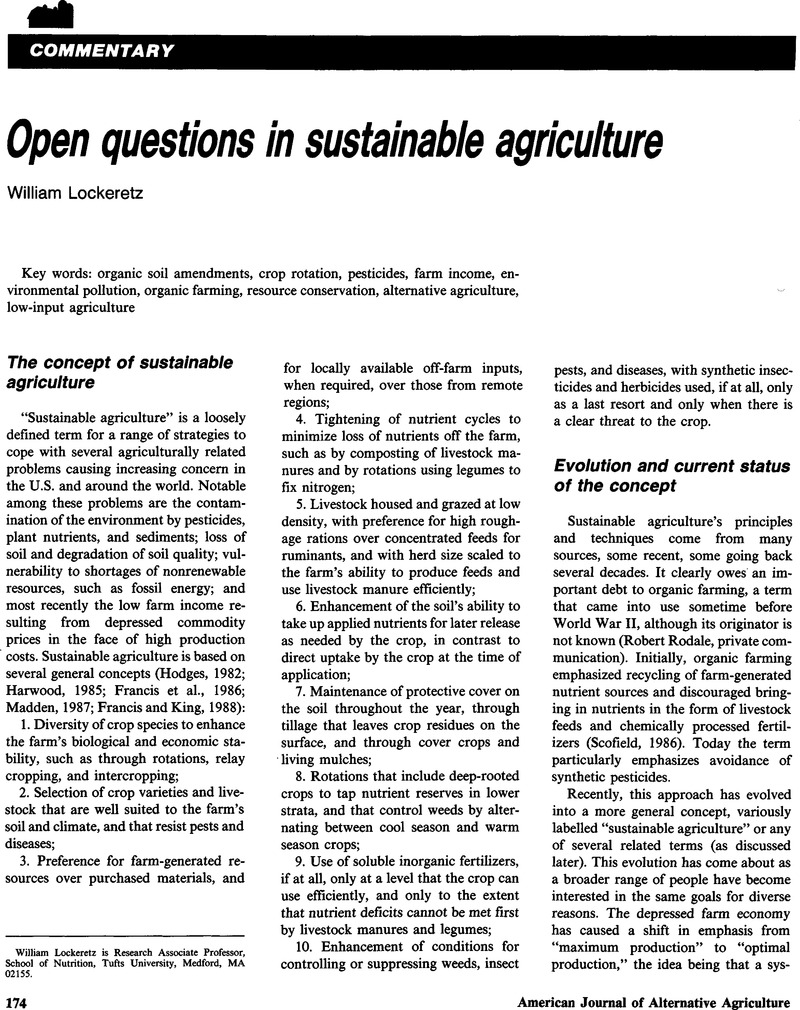Crossref Citations
This article has been cited by the following publications. This list is generated based on data provided by Crossref.
Kirschenmann, Frederick
1989.
Low-input farming in practice: Putting a system together and making it work.
American Journal of Alternative Agriculture,
Vol. 4,
Issue. 3-4,
p.
106.
Lockeretz, William
1989.
Comparative local economic benefits of conventional and alternative cropping systems.
American Journal of Alternative Agriculture,
Vol. 4,
Issue. 2,
p.
75.
Schaefer, Peter R.
1989.
Trees and Sustainable Agriculture.
American Journal of Alternative Agriculture,
Vol. 4,
Issue. 3-4,
p.
173.
Parr, J. F.
Stewart, B. A.
Hornick, S. B.
and
Singh, R. P.
1990.
Advances in Soil Science.
Vol. 13,
Issue. ,
p.
1.
MacRae, Rod J.
Hill, Stuart B.
Henning, John
and
Bentley, Alison J.
1990.
Policies, programs, and regulations to support the transition to sustainable agriculture in Canada.
American Journal of Alternative Agriculture,
Vol. 5,
Issue. 2,
p.
76.
Korsching, Peter F.
and
Malia, James E.
1991.
Institutional support for practicing sustainable agriculture.
American Journal of Alternative Agriculture,
Vol. 6,
Issue. 1,
p.
17.
Lockeretz, William
1991.
Multidisciplinary Research and Sustainable Agriculture.
Biological Agriculture & Horticulture,
Vol. 8,
Issue. 2,
p.
101.
Swanton, Clarence J.
and
Weise, Stephan F.
1991.
Integrated Weed Management: The Rationale and Approach.
Weed Technology,
Vol. 5,
Issue. 3,
p.
657.
Crews, Timothy E.
Mohler, Charles L.
and
Power, Alison G.
1991.
Energetics and ecosystem integrity: The defining principles of sustainable agriculture.
American Journal of Alternative Agriculture,
Vol. 6,
Issue. 3,
p.
146.
Lockeretz, William
1991.
The organization and coverage of research on reduced use of agricultural chemicals.
Agriculture, Ecosystems & Environment,
Vol. 36,
Issue. 3-4,
p.
217.
Allen, Patricia
Van Dusen, Debra
Lundy, Jackelyn
and
Gliessman, Stephen
1991.
Integrating social, environmental, and economic issues in sustainable agriculture.
American Journal of Alternative Agriculture,
Vol. 6,
Issue. 1,
p.
34.
Allen, Patricia L.
and
Sachs, Carolyn E.
1991.
The social side of sustainability: Class, gender and race.
Science as Culture,
Vol. 2,
Issue. 4,
p.
569.
1992.
Agriculture in Dry Lands - Principles and Practice.
Vol. 26,
Issue. ,
p.
405.
Caporali, F.
and
Onnis, A.
1992.
Validity of rotation as an effective agroecological principle for a sustainable agriculture.
Agriculture, Ecosystems & Environment,
Vol. 41,
Issue. 2,
p.
101.
Lefroy, E. C.
Salerian, J.
and
Hobbs, R. J.
1993.
Reintegrating Fragmented Landscapes.
p.
209.
Hesterman, O.B.
and
Thorburn, T.L.
1994.
A Comprehensive Approach to Sustainable Agriculture: W. K. Kellogg's Integrated Farming Systems Initiative.
Journal of Production Agriculture,
Vol. 7,
Issue. 1,
p.
132.
Ali, A
1995.
Population pressure, environmental constraints and agricultural change in Bangladesh: examples from three agroecosystems.
Agriculture, Ecosystems & Environment,
Vol. 55,
Issue. 2,
p.
95.
Duvick, Donald N.
1995.
Biotechnology is compatible with sustainable agriculture.
Journal of Agricultural and Environmental Ethics,
Vol. 8,
Issue. 2,
p.
112.
Wolf, Steven A.
and
Allen, T.F.H.
1995.
Recasting alternative agriculture as a management model: The value of adept scaling.
Ecological Economics,
Vol. 12,
Issue. 1,
p.
5.
Ikerd, John
Devino, Gary
and
Traiyongwanich, Suthijit
1996.
Evaluating the sustainability of alternative farming systems: A case study.
American Journal of Alternative Agriculture,
Vol. 11,
Issue. 1,
p.
25.





